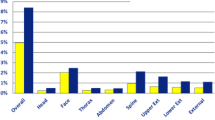Abstract
Physical disabilities may affect a child passenger’s fit within a conventional motor vehicle restraint. The aim of this study is to describe and compare injury risk in motor vehicle crashes (MVC) among children with and without special physical health care needs (SPHCN). This analysis, conducted in 2007–2008, utilizes data collected between December 1998 and November 2002 in a cross-sectional study of children ≤15 years old involved in crashes of State-Farm insured vehicles in 15 states and the District of Columbia. Parent reports via telephone survey were used to define pre-crash SPHCN, restraint status, and occurrence of significant injuries using a validated survey. Complete data were collected for 18,852 children aged 0–15 years; 159 children were reported to have a SPHCN (0.8% and 0.7% of children aged 0–8 and 9–15 years, respectively). A greater proportion of children with SPHCN aged 0–8 years were appropriately restrained (P < 0.001), but there was no significant difference in restraint use among children with and without SPHCN aged 9–15 years. There was no significant association between the presence of a SPHCN and injury risk in either age group, after adjustment for child/driver characteristics (children aged 0–8 years: OR 1.27, 95% CI: 0.48–3.33; children aged 9–15 years: OR 1.51, 95% CI: 0.38–6.11). Children with and without SPHCN have similar injury risk in MVC, despite increased age-appropriate restraint usage among children aged 0–8 years. When counseling families about vehicle safety, practitioners should consider the fit of a child with SPHCN in a restraint system.
Similar content being viewed by others
References
The American Academy of Pediatrics, Committee on Injury and Poison Prevention. (1999). Transporting children with special health care needs. Pediatrics, 104, 988–992.
National Highway Traffic Safety Administration. (2009). Child passenger safety. Available: http://www.nhtsa.dot.gov/portal/site/nhtsa/menuitem.9f8c7d6359e0e9bbbf30811060008a0c/. Accessed May 6, 2009.
The American Academy of Pediatrics, Committee on Injury and Poison Prevention. (2002). Selecting and using the most appropriate car safety seats for growing children: Guidelines for counseling parents. Pediatrics, 109, 550–553.
Gilbert, S. R., Gilbert, A. C., & Henderson, R. C. (2004). Skeletal maturation in children with quadriplegic cerebral palsy. Journal of pediatric orthopedics, 24, 292–297.
Henderson, R. C., Lark, R. K., Gurka, M. J., et al. (2002). Bone density and metabolism in children and adolescents with moderate to severe cerebral palsy. Pediatrics, 110, e5.
Rauch, F., Travers, R., Parfitt, A. M., et al. (2000). Static and dynamic bone histomorphometry in children with osteogenesis imperfecta. Bone, 26, 581–589.
Winston, F. K., Durbin, D. R., Kallan, M. J., et al. (2000). The danger of premature graduation to seat belts for young children. Pediatrics, 105, 1179–1183.
Arbogast, K. B., Durbin, D. R., Morris, S. D., et al. (2000). Assessing child restraint misuse by parental survey. Injury Prevention, 6, 145–147.
The Abbreviated Injury Scale, 1990 Revision. Des Plaines, IL: Association for the Advancement of Automotive Medicine. (1990), 74 pp.
Durbin, D. R., Winston, F. K., Applegate, S. M., et al. (1999). Development and validation of the Injury Severity Assessment Survey/Parent Report: A new injury severity assessment survey. Archives of Pediatrics and Adolescent Medicine, 153, 404–408.
Huang, P., Kallan, M. J., O’Neil, J., et al. (2009). Children with special health care needs: Patterns of safety restraint use, seating position, and risk of injury in motor vehicle crashes. Pediatrics, 123, 518–523.
Winston, F. K., Kallan, M. J., Elliott, M. R., et al. (2007). Effect of booster seat laws on appropriate restraint use by children 4 to 7 years old involved in crashes. Archives of Pediatrics and Adolescent Medicine, 161, 270–275.
Korn, T., Katz-Leurer, M., Meyer, S., et al. (2007). How children with special needs travel with their parents: Observed versus reported use of vehicle restraints. Pediatrics, 119, E637–E642.
Winter, S., Autry, A., Boyle, C., et al. (2002). Trends in the prevalence of cerebral palsy in a population-based study. Pediatrics, 110, 1220–1225.
Acknowledgments
The authors would like to acknowledge the commitment and financial support of State Farm Mutual Automobile Insurance Company® for the creation and ongoing maintenance of the Partners for Child Passenger Safety (PCPS) program, the source of data for this study. The authors also thank the many State Farm® policyholders who consented to participate in PCPS. The results presented in this report are the interpretation solely of the author(s) and are not necessarily the views of State Farm®.
Author information
Authors and Affiliations
Corresponding author
Rights and permissions
About this article
Cite this article
Huang, P., Kallan, M.J., O’Neil, J. et al. Children with Special Physical Health Care Needs: Restraint Use and Injury Risk in Motor Vehicle Crashes. Matern Child Health J 15, 949–954 (2011). https://doi.org/10.1007/s10995-009-0539-1
Published:
Issue Date:
DOI: https://doi.org/10.1007/s10995-009-0539-1




